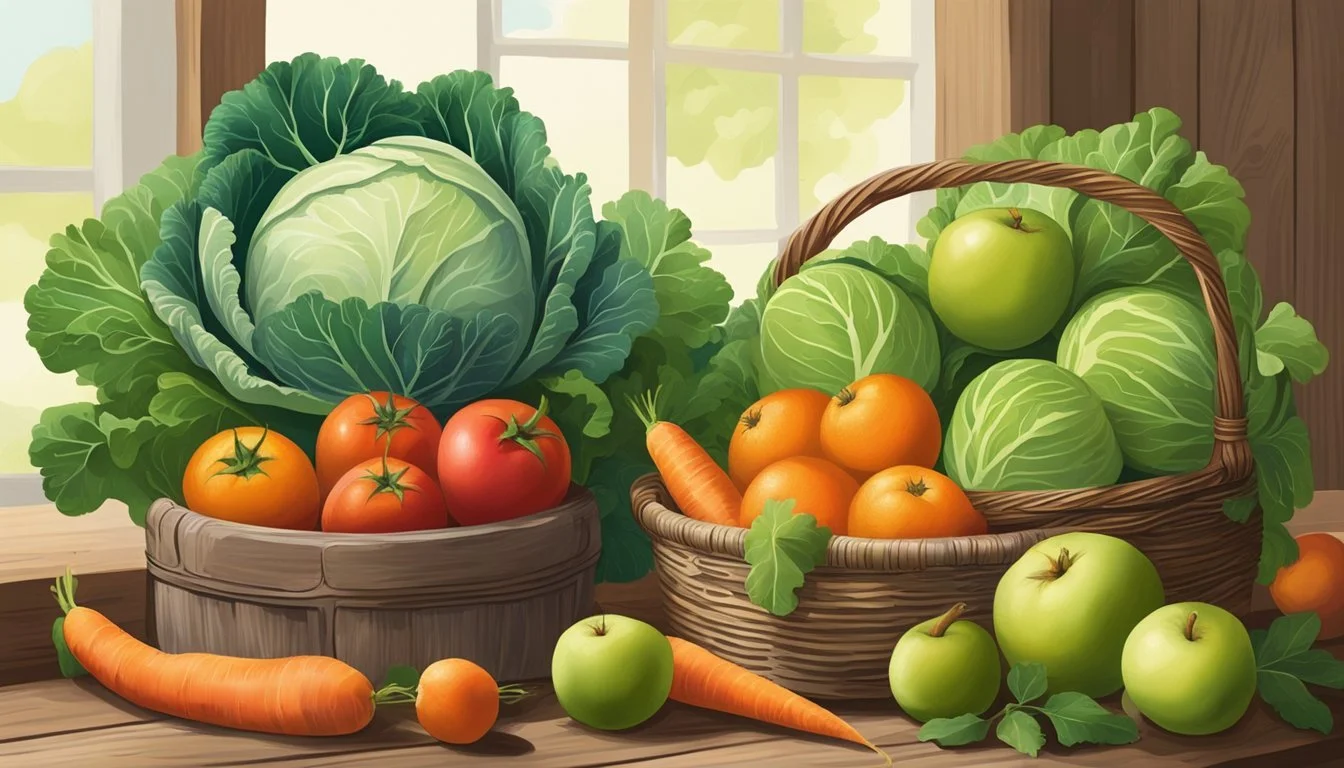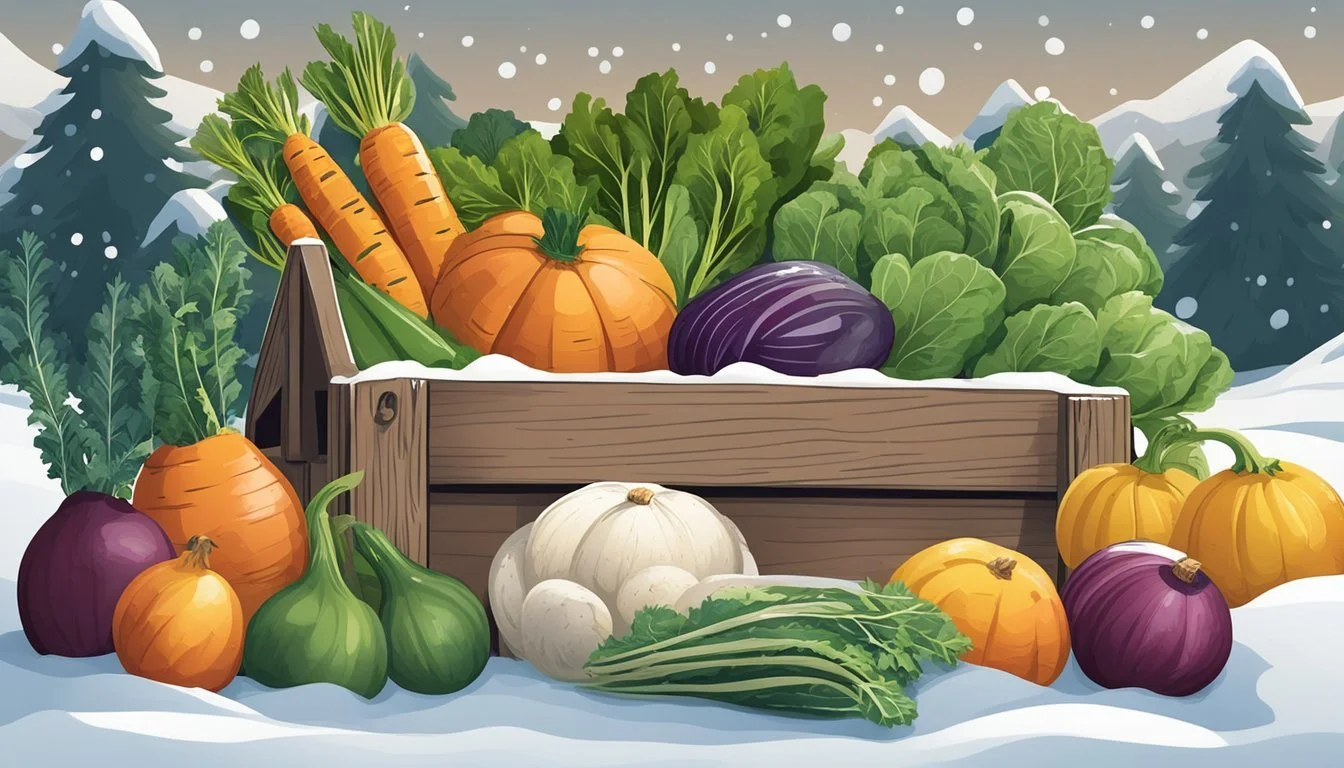Ohio Seasonal Fruit & Vegetables in February
Your Winter Produce Guide
This Article is Part of our Ohio Seasonal Fruit & Veg Calendar
February in Ohio brings with it a shift in the local produce landscape. While the winter frost still lingers and the fields lay mostly dormant, there is a surprising variety of fruits and vegetables that remain in season. These seasonal offerings provide freshness and local flavor to Ohio’s culinary scene despite the chill. Consumers looking for the freshest produce during this time will find that Ohio's cold storage techniques and facilities allow for an extended availability of certain crops.
The month's bounty includes storage crops harvested in the fall and those that thrive in the colder temperatures. Root vegetables like parsnips, sweet potatoes, and turnips remain available and are often at their sweetest following the first frost. Apples, from the fall harvest, are typically still crisp and flavorful from storage. Greenhouse-grown produce such as lettuces and herbs also contribute to the winter selection. These winter-hardy options are versatile for cooking and offer nutrient-dense choices for seasonal meals.
Local farms often extend the availability of their products through the use of greenhouses and other season-extension methods. This resilience in farming ensures that even in the colder months, Ohioans can still enjoy a range of produce. Shoppers interested in supporting local agriculture can look for these seasonal foods at farmers' markets, food cooperatives, and specialty stores across the state.
Overview of Ohio's Seasonal Produce
In February, Ohio's seasonal produce is affected by the state's cold winter climate, which influences both the availability and the types of produce that can be grown during this month.
Understanding Seasonality
In Ohio, seasonality plays a significant role in determining the availability of fruits and vegetables. The state's winter season, typically running from December to February, often sees a limited variety of fresh produce due to the frigid temperatures and shorter daylight hours. However, some hardy vegetables can withstand the colder conditions, and certain types of storage crops are still accessible. Seasonal produce charts or calendars provide valuable guidance to consumers looking to understand what is typically harvested during this time.
Winter Farming Practices in Ohio
Farmers in Ohio adapt to the challenging winter months by employing various farming practices such as using greenhouses and cold frames to extend the growing season for certain crops. Storage of fall-harvested produce like root vegetables and apples allows them to be available throughout the winter. These methods all contribute towards maintaining a supply of seasonal produce during Ohio's winter, although the variety may be more restricted compared to other seasons.
February's Featured Fruits
In Ohio, February may be brisk, but it still offers a bounty of citrus and exotic fruits that are at their peak. From the zesty tang of various citrus fruits to the limited availability of certain exotic varieties, consumers can enjoy a range of flavors even in the colder months.
Citrus Fruits in Ohio
Citrus fruits are prominently available and are a highlight in Ohio's February produce lineup. Varieties that one may find include:
Blood Oranges: Distinct for their deep red hue and a slightly berry-like flavor.
Lemons: Eureka and Meyer lemons are commonly found, with Meyer lemons being sweeter and less acidic.
Oranges: Navel oranges are a winter staple, known for their balance of sweetness and acidity.
Grapefruits: Including the ruby variety, grapefruits are known for their juicy, tangy segments.
These citrus fruits are not just flavorful; they are also packed with vitamin C, which is essential during the winter months for maintaining a healthy immune system.
Exotic Fruit Availability
When it comes to exotic fruits in Ohio during February, one can find:
Kiwi: This small fruit provides a tart and tangy taste with a unique texture.
Pomegranates: Though not grown locally, pomegranates are often available and offer a burst of sweet and tart flavors, along with a host of antioxidants.
While the local climate may not support all exotic fruits, imports help diversify the selection available to consumers looking for a taste of something different during the winter season.
February's Highlighted Vegetables
In Ohio, February's vegetable bounty is hearty and robust, featuring an array of root vegetables and hardy greens that can withstand the cold winter temperatures. These vegetables are not only flavorful but also packed with nutrients essential for maintaining good health during the colder months.
Root Vegetables and Squash
Carrots: These are a staple in Ohio during February. Rich in beta-carotene, carrots can be roasted, steamed, or eaten raw.
Potatoes: A versatile choice, potatoes are available in several varieties and are perfect for mashing, baking, or roasting.
Onions and Garlic: Essential for adding depth to winter dishes, onions and garlic store well and are available throughout the season.
Turnips: Often underappreciated, turnips can be a delicious addition to stews and are a great source of vitamin C.
Squash: Types of winter squash like butternut or acorn offer a sweet, nutty flavor and can be baked, pureed, or used in soups.
Leafy Greens and Cruciferous Veggies
Kale: (What wine goes well with kale?) Known for its resilience to cold, kale is a nutrient powerhouse that can be used in salads or cooked down for a warming side dish.
Spinach: Although tender, spinach can be grown in cold conditions and provides a good source of iron and folate.
Broccoli and Cauliflower: These cruciferous vegetables are perfect for roasting or adding to casseroles.
Cabbage: Durable and versatile, cabbage is ideal for slaws or fermented dishes like sauerkraut (how long does sauerkraut last?).
Brussels Sprouts: Their small, compact size makes them perfect for roasting and they offer a burst of flavor and nutrients.
Harvesting and Storage
In Ohio, the month of February poses unique challenges for harvesting and storage due to the cold weather. Farmers must employ specific techniques to ensure the late winter crops, such as winter squash, are harvested with care to maintain quality and freshness throughout storage.
Proper Techniques for Winter Harvest
Winter Squash: Farmers typically harvest winter squash before the first frost and cure it at 80-85°F for 10 days to enhance storage life. They handle it gently to prevent bruising.
Harvesting tools: Sharp, clean shears or knives are used to cut the squash from the vine, leaving a small portion of stem attached.
Handling: The crops are carefully transported to avoid dropping or piling up high, which can cause damage.
Storage Solutions for Freshness
For optimal storage, different crops require particular environments to maintain their freshness. Farmers in Ohio use a variety of storage solutions to extend the shelf life of their produce.
Temperature and Humidity Controlled Environments:
Apples: Stored at 32-40°F with high humidity.
Potatoes: Kept in cool, well-ventilated areas at 45-50°F, away from light to prevent greening.
Dry Onions: Stored in well-ventilated pantry areas, separate from potatoes to prevent spoilage.
Farmers utilize these controlled conditions to preserve the quality of harvested crops until they reach the market or the consumer's table.
Seasonal Recipes and Preparation Ideas
February in Ohio brings a unique opportunity to create dishes that are both flavorful and nourishing using local seasonal produce. Capturing the essence of winter's bounty, chefs and home cooks alike can craft heartwarming meals and delightful side dishes that bring comfort during the chilly month.
Creating Hearty Winter Meals
During the colder months, Ohioans turn to hearty meals that provide warmth and satisfaction. Soups and stews are particularly popular, making use of robust flavors from seasonal vegetables. A classic example is a thick, creamy butternut squash soup. It's a simple dish where the squash's natural sweetness is enhanced with a touch of cinnamon and nutmeg, then pureed to a velvety texture. Another staple is roasted broccoli, which can be transformed into a fulfilling entree when combined with proteins such as tofu (how long does tofu last?), chicken, or beef, and seasoned with garlic and a splash of lemon juice for a subtle tang.
Sweet and Savory Side Dishes
Side dishes in February utilize the greens that thrive during this time. Kale, for instance, can be turned into a kale salad garnished with slivers of apple or pear, walnuts (how long do walnuts last?), and a drizzle of balsamic vinaigrette. This salad juxtaposes the kale's earthy tones with the fruits' sweetness and the vinaigrette's acidity, making it a complex but balanced dish.
On the savory side, a salsa made with preserved or greenhouse-grown tomatoes provides a fresh, zesty counterpoint to creamy or starchy dishes. For the sweet note, chefs often involve desserts featuring local fruits like apples, which can be baked into pies or crisps. Utilizing these ingredients, residents can extend the joy of fresh produce into the winter months, cherishing the flavors until spring arrives.
Local Food Movements and Events
The heart of Ohio's local food movements in February revolves around the support of regional farmers and the promotion of seasonal produce through farmers' markets and Community Supported Agriculture (CSA) programs.
Farmer's Markets in February
Farmers' markets operate with reduced frequency during February due to the state's colder climate. However, select markets do open their doors to offer winter-hardy produce and goods. Customers can usually find staple items like potatoes, onions, and cold-stored apples from dedicated vendors. The Ohio Farm Bureau emphasizes the importance of these markets in supporting the local economy and providing access to farm-fresh foods.
Note: Locations and times can be subject to change; it is advisable to search for the latest updates via local market websites or information centers.
Community Supported Agriculture (CSA)
CSA programs gain momentum as farmers and consumers form partnerships for the upcoming growing season. Participants typically purchase a share of the crop yields and, in return, the farmers provide a regular supply of produce throughout the harvest period. While February may not have an abundance of fresh veggies, CSAs often offer products such as preserves, baked goods, and meats during this time.
Advantages: Consumers get to support local farmers directly and receive a portion of the highest quality product derived from the Ohio soil.
Sign-Up: Interested individuals should seek CSA opportunities early in the year to secure their share, contacting local farms or using dept resources like the Ohio Department of Agriculture for information.







